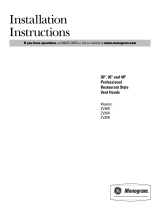
RECOMMANDATIONS ET SUGGESTIONS
AVERTISSEMENT
1. Avant de procéder à l'entretien ou au nettoyage de l'appareil, débranchez ou couper l'alimentation
électrique de la hotte
.
2.
POUR RÉDUIRE LE RISQUE D'UN FEU DE GRAISSE DE LA HOTTE:
A.
Ne laissez jamais les éléments de surface sans surveillance à des réglages élevés. Les
déversements causent de la fumée et les débordements graisseux peuvent s'enflammer
.
Chauffez lentement les huiles à feu doux ou moyen.
B.
Allumez toujours la hotte lorsque vous cuisinez à feu vif ou lorsque vous flambez d’aliments (crêpes
Suzette, cerises Jubilee, steak au poivre flambé).
C.
Nettoyez fréquemment le dispositif de ventilation. La graisse ne doit pas s'accumuler sur le
ventilateur ou le filtre.
D.
Utilisez une poêle de dimension appropriée. Utilisez toujours des ustensiles de cuisson adaptés à la
grandeur de l'élément de surface
.
3.
Utilisez une poêle de dimension appropriée. Utilisez toujours des ustensiles de cuisson adaptés à la
grandeur de l'élément de surface
:
A.
ÉTOUFFEZ LES FLAMMES avec un couvercle bien ajusté, une plaque à biscuits ou plateau de métal,
puis éteignez le brûleur. FAITES ATTENTION AUX BRÛLURES. Si les flammes ne s'éteignent pas
immédiatement, ÉVACUEZ ET APPELEZ LE SERVICE D'INCENDIE
.
B.
NE RAMASSEZ JAMAIS UN PLAT ENFLAMMÉ - Vous risquez de vous brûler.
C.
N’UTILISEZ PAS D'EAU, y compris des serviettes ou des torchons mouillés - une violente explosion de
vapeur pourrait en résulter.
D. Utilisez un extincteur SEULEMENT SI :
1)
Vous savez que vous avez un extincteur de classe ABC et vous savez déjà comment l'utiliser.
2)
Le feu est petit et contenu dans la zone où il a commencé.
3)
Le service d'incendie a été appelé.
4)
Vous pouvez combattre l'incendie en ayant le dos orienté vers une sortie.
4.
Pour réduire le risque d'incendie ou de décharge électrique, n'utilisez pas ce ventilateur avec un
dispositif de contrôle de vitesse à semi-conducteurs
.
5.
Pour assurer une protection contre les décharges électriques, ne branchez l'appareil que sur des prises
correctement mises à la terre
.
MISE EN GARDE : Pour une ventilation générale uniquement. Ne pas utiliser pour évacuer des matières
et vapeurs dangereuses ou explosives
.
20





















